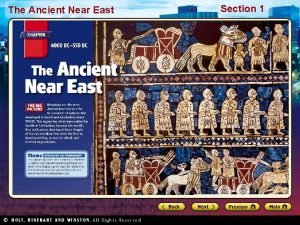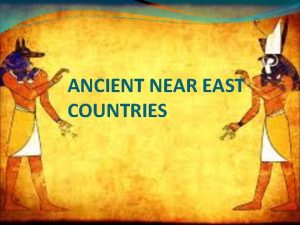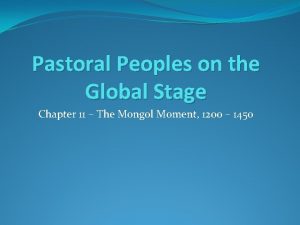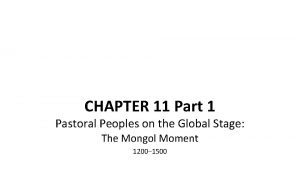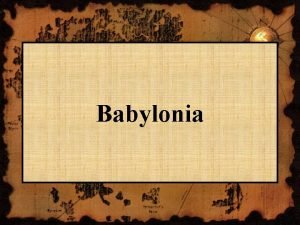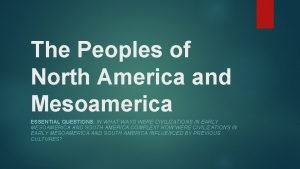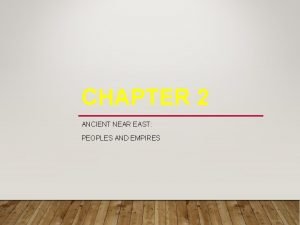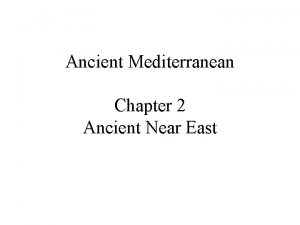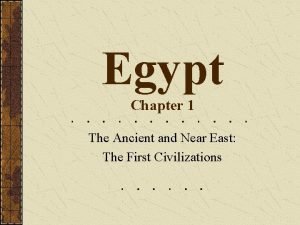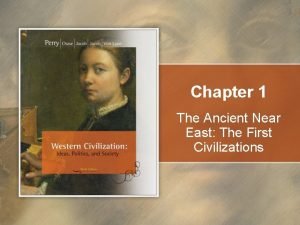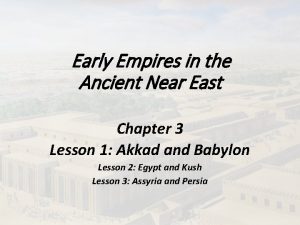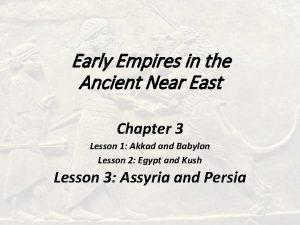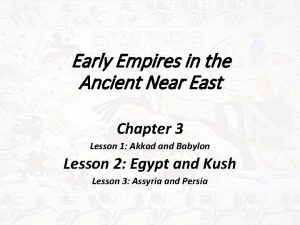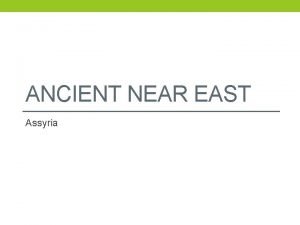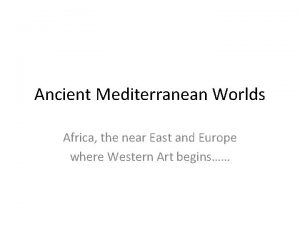Chapter 2 The Ancient Near East Peoples and
















- Slides: 16

Chapter 2 The Ancient Near East: Peoples and Empires

The Hebrews: “The Children of Israel” § § § Hebrew Bible (Christian Old Testament) Descendants of Abraham Migration to Egypt § § § Slaves of pharaohs Moses leads them out of Egypt (Exodus) 12 Tribes Troubles with the Philistines The emergence of the Israelites as a distinct group of peoples (c. 1200 – c. 1000 B. C. E. )

The United Kingdom § Biblical Leaders § § § Saul (c. 1020 – 1000 B. C. E. ) David (c. 1000 – 970 B. C. E. ) Solomon (c. 970 – 930 B. C. E. ) § § Temple of Jerusalem Recent Challenges to the Biblical Account

The Kingdoms of Israel and Judah § Kingdom of Israel § § § 10 northern tribes Capital in Samaria Kingdom of Judah § § 2 southern tribes Capital in Jerusalem

The Kingdoms of Israel and Judah § § Assyrian Conquest of the Kingdom of Israel (722 B. C. E. ) Chaldean Conquest of the Kingdom of Judah (586 B. C. E. ) § § Jerusalem destroyed The Babylonian Captivity

The Spiritual Dimensions of Israel § “I am the Lord your God” § § Yahweh (monotheism) “You only have I chosen”: Covenant and Law § § Covenant with Yahweh during the Exodus Law § § § 10 Commandments Regulation of economic, social and political life of all Hebrews Prophets § § § Yahweh’s voice to his people Universalism and social justice Separation between Jews and non-Jews

Social Structure of the Hebrews § Social Patterns § § § Family § § “Men of rank and influence”: elites “People of the land”: commoners Central social institution in Hebrew life Marriage and Women § A perfect wife: Book of Proverbs § § § Accounts of dependence Matchmaking Woman as the “crown of man”

The Neighbors of the Israelites § § Philistines Phoenicians § § Trade Colonies throughout the Mediterranean § § Carthage Transmitters of culture § Alphabet

The Assyrian Empire § Early history § § A Semitic people, vassals of foreign rulers Independence and kings § § Ashurbanipal (669 – 627 B. C. E. ) Organization of the Empire § § Absolute kings Effective communication and administration

The Assyrian Empire § The Assyrian military machine § § § Large armies Discipline Iron weapons The use of various tactics Terror as an instrument of warfare

Assyrian Society and Culture § Imported Prisoners of War: a polyglot society § § Agriculture Trade § § Language Religion Middlemen Hybrid Culture § § Guardians of Sumerian and Babylonian culture Art § Relief sculptures

Neo-Babylonian Empire § The Chaldeans § § Nebuchadnezzar II (605 – 562 B. C. E. ) Babylon § § Hanging Gardens Conquest by the Persians in 539 B. C. E.

Persian Empire § Cyrus the Great (559 – 530 B. C. E. ) § § Cambyses (530 – 522 B. C. E. ) § § Conquered Kingdom of Lydia (c. 547 B. C. E. ) Conquered Greek city-states Conquered Mesopotamia (539 B. C. E. ) Conquered Egypt Darius the Great (521 – 486 B. C. E. ) § § § Western expansion into India Ionian revolt in Asia Minor Invasion and defeat in Greece (490 B. C. E. )

Persian Empire § Governing the Empire § § Satrapies and satraps: provincial administration Efficient communications § § Royal Road from Sardis to Susa The Great King § § The gap between king and subjects Military § The 10, 000 Immortals

Persian Religion § Zoroastrianism § § Zoroaster (born in 660 B. C. E. ) Message of monotheism § § § Ahuramazda (the “Wise Lord”) Ahriman (Evil Spirit) Struggle between good and evil Last Judgment Acceptance by the Great Kings Development of ethical dualism

Discussion Questions § § § Describe the political and social advances during the reigns of David and Solomon. How did they change Israel's society? What legacy did the ancient Hebrews leave to Western Civilization? How important is Moses for the Jewish faith? Why were the Assyrians so successful in subjugating their neighbors? What role did terror play in Assyrian military tactics? How were the Persians able to conquer and maintain their large empire? How did Cyrus earn a favorable reputation?
 Kalahari desert on africa map
Kalahari desert on africa map Early empires in the ancient near east
Early empires in the ancient near east The ancient near east
The ancient near east Ancient near east countries
Ancient near east countries Ancient near east countries physical education
Ancient near east countries physical education Classical brigade system
Classical brigade system Rugby style tackling
Rugby style tackling East is east and west is west
East is east and west is west Chapter 8 section 1 latin american peoples win independence
Chapter 8 section 1 latin american peoples win independence Pastoral peoples on the global stage
Pastoral peoples on the global stage Chapter 11 pastoral peoples on the global stage
Chapter 11 pastoral peoples on the global stage What is the horizontal movement of air called
What is the horizontal movement of air called Communication in ancient time
Communication in ancient time Ancient india vs ancient china
Ancient india vs ancient china Cahokia apush definition
Cahokia apush definition Many territories and peoples controlled by one government
Many territories and peoples controlled by one government The peoples of north america and mesoamerica
The peoples of north america and mesoamerica


